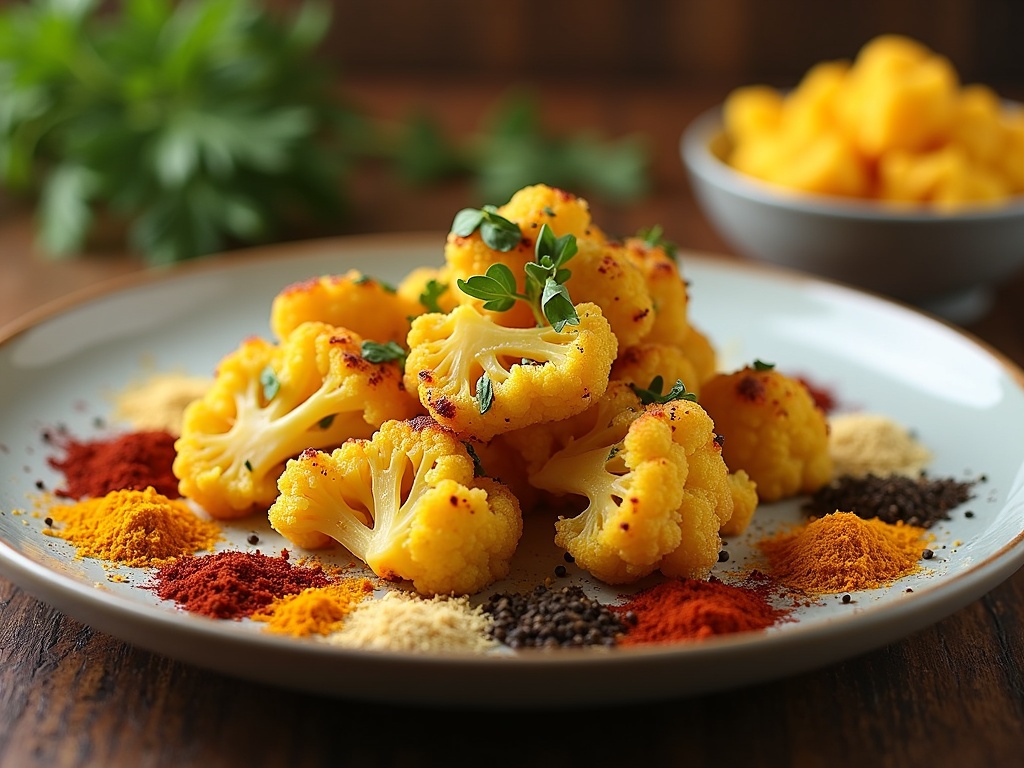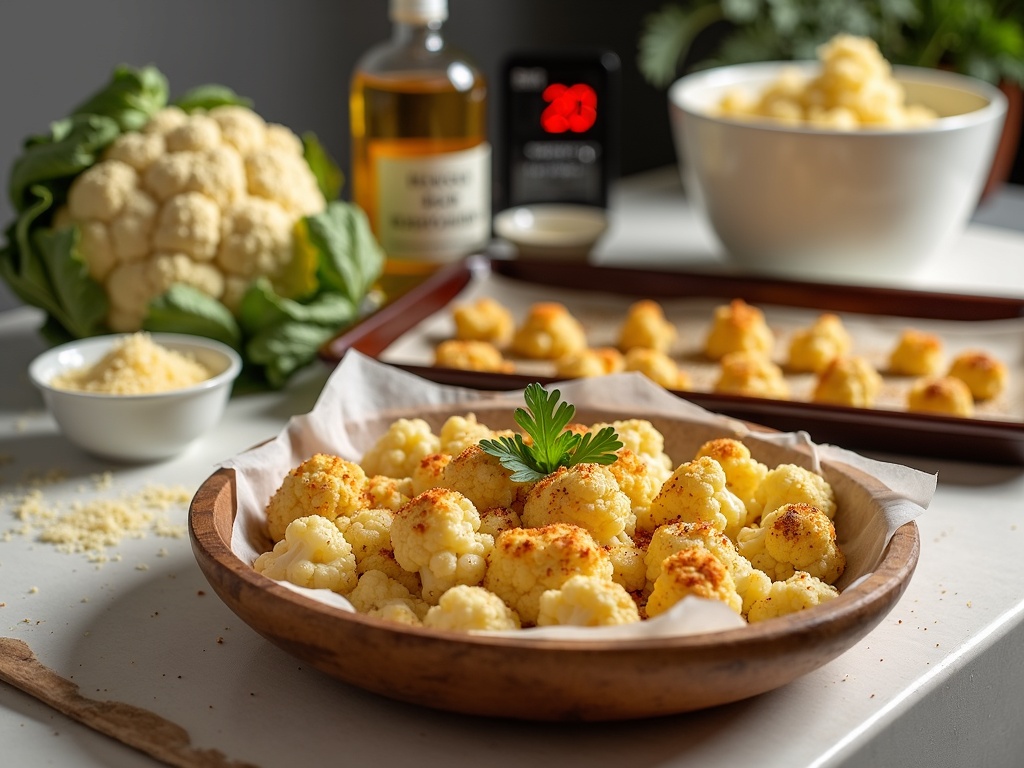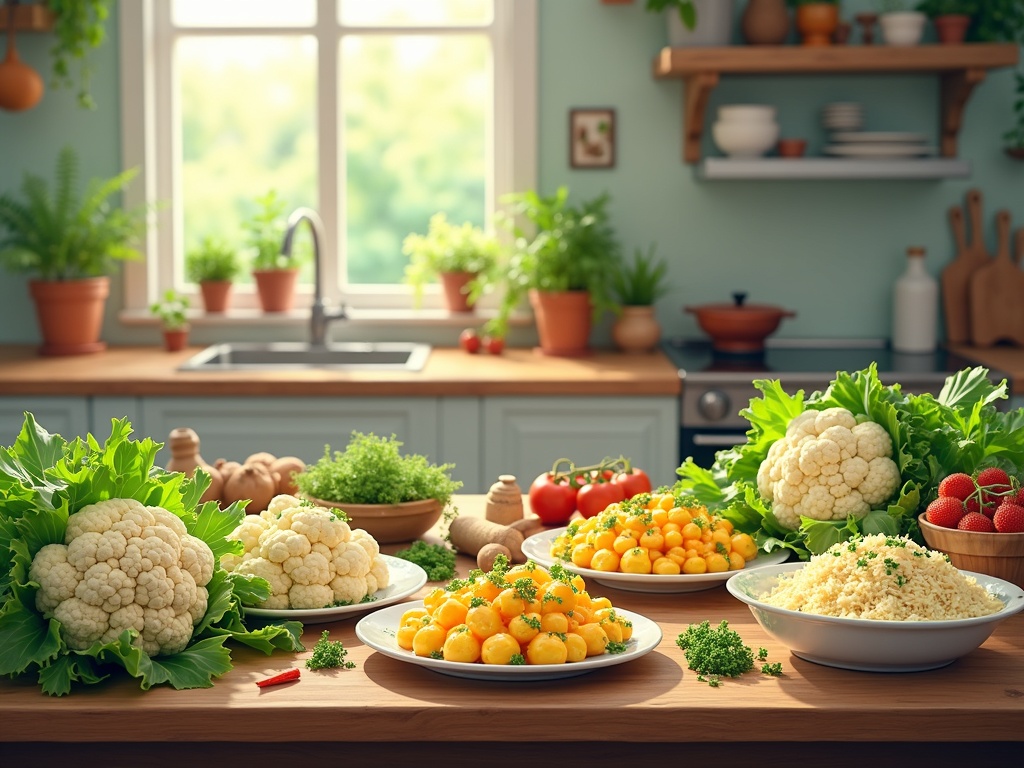Baked cauliflower transforms this versatile cruciferous vegetable into a nutritional powerhouse with rich, caramelized flavors that far surpass its raw state. When properly prepared and seasoned, this low-calorie vegetable develops a delicious nutty taste while maintaining its impressive profile of vitamins, minerals, and antioxidants.
Find In This Article
Key Takeaways
- Cauliflower is a nutrient-dense option with only 25 calories per cup, making it an excellent lower-calorie alternative to starchy vegetables like potatoes.
- Baking cauliflower at 425°F for 20-25 minutes creates the perfect balance of tender centers with golden-brown, caramelized edges.
- Proper preparation—including uniform cutting, thorough drying, and light oil coating—is crucial for achieving the ideal crispy texture.
- Cauliflower readily absorbs flavors, making it extremely versatile for various cuisines and preparation methods like steaks, rice, and buffalo bites.
- As an eco-friendly vegetable choice, cauliflower requires less water than many alternatives and creates minimal food waste since almost the entire plant is edible.
Why Cauliflower is the Perfect Vegetable to Bake
Cauliflower has become my go-to vegetable for baking due to its impressive nutritional profile and versatility in the kitchen. This humble cruciferous vegetable transforms when roasted, developing a nutty, caramelized flavor that’s far more complex than its raw state. Let me share why cauliflower deserves a prime spot in your baking rotation.
Nutritional Powerhouse with Fewer Calories
Cauliflower offers an impressive nutritional bang for your caloric buck. With just 25 calories per cup (124g serving), it provides significant volume and satisfaction while keeping calorie counts low. This makes cauliflower an exceptional alternative to higher-calorie starches like potatoes, which contain approximately 130 calories per cup.
The nutritional breakdown is equally impressive:
- 2g of protein per cup
- 5g of carbohydrates
- 2g of dietary fiber (7% of your daily recommended intake)
I’ve found cauliflower to be particularly valuable for creating satisfying meals without the calorie density of traditional starches. The fiber content also helps promote feelings of fullness, making it easier to manage portion sizes naturally.
Perfect for Health-Conscious Cooking
Cauliflower’s low calorie count and substantial nutrient profile make it ideal for those focused on weight management. I can create dishes that feel indulgent while supporting health goals – a rare combination in the culinary world.
The versatility of baked cauliflower extends to numerous preparation methods. I can roast florets until golden and crispy, slice into “steaks” for a hearty main course, or process it into “rice” before baking for a lighter grain alternative. For a truly special treat, I sometimes create a delicious cauliflower cheese recipe that satisfies comfort food cravings with significantly fewer calories than traditional options.
What’s particularly valuable about baked cauliflower is how it readily absorbs flavors. Unlike some low-calorie vegetables that remain bland despite seasoning, cauliflower develops complex flavors when baked. The dry heat of the oven concentrates its natural sweetness while creating delicious browned edges.
When comparing cauliflower to other baking vegetables, its neutral flavor profile gives it an advantage. Where strong-flavored vegetables might limit your seasoning options, cauliflower works as a canvas for countless flavor combinations – from simple salt and olive oil to complex spice blends from various global cuisines.
The fiber content in cauliflower does more than just contribute to feeling full – it supports digestive health and can help maintain steady blood sugar levels. This makes baked cauliflower dishes appropriate for many specialized dietary approaches, including those designed for blood sugar management.
I’ve found that baking cauliflower brings out its best qualities. The high heat caramelizes the natural sugars, creating depth of flavor while maintaining the vegetable’s nutritional integrity. This transformation turns a sometimes overlooked vegetable into the star of any meal – all while keeping calories low and nutrients high.
When you’re looking for a vegetable that can satisfy both your nutritional goals and your taste buds, baked cauliflower delivers consistently impressive results with minimal effort.
Power-Packed Health Benefits You Should Know
Baked cauliflower isn’t just a delicious side dish – it’s a nutritional powerhouse that deserves a spot in your regular meal rotation. I’ve discovered that this humble vegetable delivers an impressive array of health benefits while maintaining its nutritional integrity when baked properly.
Essential Vitamins and Minerals
Cauliflower comes loaded with an impressive vitamin profile that remains largely intact through the baking process. A single cup of cauliflower contains approximately 77% of your daily vitamin C requirements, boosting your immune system and promoting skin health. This same serving also provides about 20% of your daily vitamin K needs, supporting bone health and proper blood clotting.
Don’t overlook its vitamin B6 content, which delivers roughly 13% of your daily requirements. B6 plays a crucial role in brain development and function while helping your body convert food into energy. These vitamins work together to support overall health and wellness when you enjoy a serving of baked cauliflower.
The versatility of cauliflower makes it perfect for various baking methods. You can try it as a standalone dish or incorporate it into something more elaborate like a cauliflower cheese recipe for additional flavor and nutritional benefits.
Powerful Antioxidant Protection
Cauliflower stands out for its rich antioxidant profile, particularly its sulforaphane content. This compound has gained attention in research circles for its potential to reduce cancer risk. Sulforaphane works by activating detoxification enzymes in your liver that help neutralize harmful compounds before they can damage cells.
The antioxidants in cauliflower effectively combat oxidative stress, which is linked to aging and various chronic diseases. When you bake cauliflower, you preserve many of these beneficial compounds while creating a tasty dish that supports your health goals.
Studies have consistently shown that cruciferous vegetables like cauliflower have cancer-fighting properties. The combination of fiber, antioxidants, and anti-inflammatory compounds creates a protective effect that may reduce the risk of several cancer types, including:
- Colorectal cancer
- Lung cancer
- Breast cancer
- Prostate cancer
The baking process can actually enhance the bioavailability of certain compounds in cauliflower, making it easier for your body to absorb and use these beneficial nutrients. When roasted with a small amount of healthy oil, fat-soluble vitamins become more accessible to your body.
I find that baking cauliflower at around 425°F (220°C) for 20-25 minutes creates the perfect balance of flavor and nutrition. This cooking method caramelizes the natural sugars in the vegetable while preserving its nutrient content. The result is a dish that’s not only good for you but genuinely enjoyable to eat.
Adding spices like turmeric, black pepper, or cumin to your baked cauliflower can further boost its antioxidant properties while creating exciting flavor profiles. These spice combinations not only enhance taste but complement the already impressive nutritional profile of this versatile vegetable.
For those tracking their daily nutrient intake, cauliflower provides these benefits while remaining low in calories (about 25 calories per cup) and carbohydrates (5g per cup), making it an excellent choice for various dietary approaches, from plant-based to ketogenic diets.

The Secret to Perfect Baked Cauliflower
I’ve perfected the art of baking cauliflower after countless tries in my kitchen. The key lies in understanding a few fundamental techniques that transform this humble vegetable into a flavor-packed dish your family will request again and again.
Preparation Is Everything
Before baking, proper preparation makes all the difference. Start by washing your cauliflower thoroughly under cold running water. I remove the outer leaves and trim the stem, then cut it into evenly-sized florets – about 1.5 inches each. Consistent sizing ensures they cook at the same rate, preventing some pieces from burning while others remain undercooked.
For drying, I pat the florets with paper towels or use a salad spinner. Removing excess moisture is crucial for achieving that golden-brown exterior we’re after. Once dry, place them in a large mixing bowl, drizzle with 2-3 tablespoons of olive oil, and toss until every piece is lightly coated.
seasoning is where you can get creative. The basics include salt and black pepper, but I often add:
- Garlic powder for depth of flavor
- Paprika for a smoky kick
- Cumin for an earthy note
- A sprinkle of Parmesan cheese in the last 5 minutes of baking
The coating of oil helps these seasonings stick to the florets and promotes that beautiful caramelization we’re looking for.
The Baking Process
Temperature control is non-negotiable for perfect baked cauliflower. I preheat my oven to 425°F – hot enough to create caramelization but not so hot that the outside burns before the inside cooks through. Line your baking sheet with parchment paper to prevent sticking and make cleanup easier.
Arrange the florets in a single layer with some space between each piece. Crowding the pan causes the cauliflower to steam rather than roast, resulting in a soggy texture instead of crispy edges. If you’re cooking a large batch, use two baking sheets rather than piling everything onto one.
The magic happens at around the 25-minute mark, but I check at 20 minutes and may go up to 30 depending on my oven and the size of the florets. You’re looking for tender centers with golden-brown edges – that perfect balance between softness and caramelized crispness.
For the ultimate flavor development, I flip the florets halfway through cooking. This extra step ensures even browning on all sides. You’ll notice the edges starting to darken – that’s the natural sugars in the cauliflower caramelizing, creating that nutty, sweet flavor that makes baked cauliflower so delicious.
If you’re feeling adventurous, you can take this basic technique and turn it into a full meal like a creamy cauliflower cheese bake by adding a cheese sauce in the last portion of cooking.
The cauliflower is done when a fork easily pierces through but still meets some resistance. You don’t want it mushy – a slight bite adds textural contrast that makes each mouthful interesting.
Let the baked cauliflower rest for about 5 minutes after removing it from the oven. This allows the flavors to settle and the texture to reach perfection. Serve immediately for the best taste experience, though I find it’s still delicious at room temperature as part of a buffet or packed lunch.

Creative Ways to Serve Your Baked Cauliflower
Baked cauliflower offers endless possibilities beyond the standard side dish. I’ve discovered several innovative ways to transform this versatile vegetable into impressive culinary creations that will surprise even the pickiest eaters at your table.
Signature Cauliflower Preparations
Cauliflower steaks have become my go-to option for a satisfying plant-based main course. To prepare them, I slice a whole cauliflower head vertically into 1-inch thick “steaks,” brush them with olive oil, and season generously with salt, pepper, and smoked paprika. After baking at 425°F for about 25-30 minutes, they develop a beautiful golden exterior while maintaining a tender center.
Buffalo baked cauliflower delivers that classic spicy kick without the traditional chicken. I coat cauliflower florets in a simple batter of flour, milk, and spices, then bake until crispy. Next, I toss them in buffalo sauce and return them to the oven for an additional 10 minutes. The result? Crispy, spicy bites that make perfect appetizers or game-day snacks.
Cauliflower rice has revolutionized low-carb cooking. I create this rice alternative by pulsing raw cauliflower florets in a food processor until they reach a rice-like consistency. After spreading the cauliflower rice on a baking sheet and roasting it at 400°F for 12-15 minutes, it becomes the perfect base for stir-fries, grain bowls, or as a simple side dish. The lower carbohydrate content makes it an excellent substitute for traditional rice, with approximately 5g of carbs per cup compared to white rice’s 45g.
For a Middle Eastern-inspired meal, I serve baked cauliflower with creamy dips like hummus or tzatziki. The contrast between the warm, roasted cauliflower and cool, tangy dips creates a perfect balance of flavors and textures. This combination works particularly well for casual entertaining or as part of a mezze platter.
Looking for something cheesy and comforting? My cauliflower cheese recipe transforms simple baked cauliflower into a rich, indulgent dish that satisfies comfort food cravings while still featuring vegetables as the star.
When considering portion sizes, I typically plan for about 1 cup of cauliflower rice or 1-2 cauliflower steaks per person as a main course. For buffalo cauliflower or other appetizer preparations, about ½ cup per person works well as a starter. The beauty of cauliflower is its ability to absorb flavors while remaining light, so you can enjoy generous portions without feeling overly full.
I’ve found that properly storing leftover baked cauliflower maintains its texture and flavor. Refrigerated in an airtight container, most cauliflower dishes stay fresh for 3-4 days. For cauliflower rice, I often make a large batch and freeze portions in zip-top bags for quick weeknight meals.
Don’t be afraid to experiment with global flavors when seasoning your baked cauliflower. Mediterranean-inspired versions with lemon and herbs, Indian-spiced variations with curry powder and turmeric, or East Asian profiles with soy sauce and sesame all work brilliantly with cauliflower’s neutral base.
These creative serving ideas transform humble cauliflower from a simple side dish into exciting culinary experiences that can stand as satisfying main courses, unique appetizers, or versatile bases for countless global flavors.
Eco-Friendly Choice for Your Kitchen
Cauliflower stands out as one of the more environmentally conscious vegetables I can bring into my kitchen. This versatile cruciferous vegetable isn’t just delicious when prepared properly—it’s also a smart choice for those of us concerned about our ecological footprint.
Water Conservation and Carbon Impact
Growing cauliflower requires approximately 322 gallons of water per pound, which might sound like a lot until I compare it to other staples. Potatoes, for instance, demand around 516 gallons per pound—making cauliflower a significantly more water-efficient option. In a world where water scarcity increasingly affects agriculture, this difference matters.
The carbon footprint associated with cauliflower production is also worth noting. When I buy locally grown cauliflower in season, I’m helping to reduce transportation emissions significantly. Local sourcing cuts down on fuel consumption and refrigeration needs that contribute to greenhouse gas emissions.
Sustainable farming practices further enhance cauliflower’s eco-credentials. Farmers who use regenerative techniques like:
- Crop rotation systems that include cauliflower to improve soil health
- Reduced tillage methods that preserve soil structure and carbon sequestration
- Integrated pest management that minimizes chemical interventions
- Water-efficient irrigation systems that reduce overall consumption
These practices not only benefit the environment but also tend to produce more nutritious and flavorful cauliflower. I’ve found that sustainably grown cauliflower often has better texture and taste when I transform it into dishes like a delicious cauliflower cheese or roasted florets.
Cauliflower’s environmental advantages extend to its growing season and adaptability. It thrives in moderate climates and can be grown year-round in many regions, reducing the need for energy-intensive greenhouse cultivation or long-distance shipping. This adaptability means I can often find locally grown cauliflower regardless of the season in many parts of the country.
The plant’s efficiency goes beyond just water usage. Cauliflower grows relatively quickly—typically reaching maturity in 70-120 days depending on variety and conditions. This shorter growth cycle means less time using agricultural resources compared to longer-season crops.
From a land use perspective, cauliflower provides excellent nutritional density per acre. Each plant produces a substantial head, offering significant food value from relatively little space. This efficiency translates to less farmland needed to feed more people—an increasingly important consideration as the global population continues to grow.
I’ve also noticed that cauliflower creates less food waste in my kitchen. Unlike some vegetables where I discard significant portions, almost the entire cauliflower can be used. The florets form the centerpiece of most dishes, while the stem and leaves are perfectly edible and can be incorporated into soups, stews, or stir-fries. Even the outer leaves, often discarded, can be roasted until crispy for a nutritious snack.
The growing popularity of cauliflower has encouraged farmers to adopt more sustainable practices specifically for this crop. Consumer demand for environmentally responsible food has driven improvements throughout the supply chain, from water management to packaging solutions.
By incorporating more cauliflower into my weekly meal planning, I’m making a small but meaningful choice that aligns with sustainable food systems. Its versatility in the kitchen—from rice substitute to pizza crust to hearty soups—means I can enjoy this eco-friendly vegetable in countless delicious ways while knowing I’m making a responsible choice for the planet.

Sources:
USDA FoodData Central, Cancer Research Institute, Culinary Institute of America, Journal of Agricultural Science

